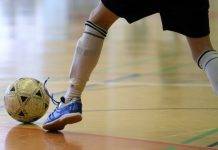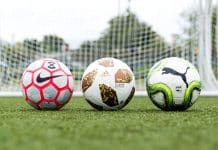Ladies and gentlemen, soccer fanatics and aspiring athletes alike, we stand before you today to unravel the age-old enigma that has puzzled many a player on the field – should you size up on soccer cleats? With a fervor that burns deep within our souls, we delved into the depths of this query, tirelessly researching and analyzing, in order to bring you a comprehensive understanding of what truly lies beneath the surface. So sit back, relax, and prepare to have your cleat-sizing world forever changed.
This image is property of i.ytimg.com.
Factors to consider
When it comes to choosing the right size for your soccer cleats, there are several factors that you need to consider. Your foot growth, the thickness of your socks, your playing style, and your personal preferences all play a role in determining the ideal fit for you. By taking these factors into account, you can make an informed decision that will enhance your performance and prevent any discomfort or injuries on the field.
Review contents
Foot growth
For growing children or teenagers, foot growth is an important factor to consider when choosing soccer cleats. Kids’ feet tend to grow quickly, and investing in a pair of cleats with room for growth can save you from having to buy new ones too soon. It’s essential to strike the right balance between a comfortable fit and allowing some room for the feet to grow.
Socks and thickness
The thickness of your socks is another aspect to consider when determining the size of your soccer cleats. Some players prefer wearing thicker socks for added cushioning and protection, while others opt for thinner socks to ensure a snug fit. If you typically wear thicker socks, sizing up may be necessary to accommodate the added bulk. On the other hand, if you prefer thin socks, sticking to your actual shoe size may provide a better fit.
Playing style
Your playing style also affects the size of cleats that would best suit you. Players who rely on speed and agility might prefer a tighter fit that allows for maximum responsiveness and control. Conversely, those who prioritize stability and power may opt for a slightly larger size to ensure a more comfortable and stable base. Your playing style should guide you towards finding a balance between a snug fit and the necessary flexibility or room for movement.
Preference
Last but not least, personal preference should play a significant role in determining the size of your soccer cleats. Some individuals prefer a snug fit for a more connected and responsive feel, while others prioritize comfort and opt for a looser fit. Evaluating your own preferences will help you make the best decision for your playing style and overall comfort on the field.
Advantages of sizing up
Sizing up on soccer cleats can offer several advantages that can enhance your playing experience and overall comfort on the field. Here are some of the benefits of choosing a larger size:
Room for growth
If you’re still growing, sizing up allows your feet to have some room for growth, saving you from having to replace your cleats too quickly. This is particularly important for young players who may experience rapid foot growth.
Extra comfort
A larger size can provide extra comfort as it allows for more space inside the cleats. This can result in less pressure on your toes and a more relaxed fit, reducing the likelihood of discomfort while playing.
Accommodate thicker socks
If you prefer wearing thicker socks for additional cushioning or warmth, sizing up can allow you to comfortably wear them without feeling too tight. This is especially useful during colder weather conditions or when playing on rough surfaces that might require extra padding.
Reduced risk of blisters
Wearing cleats that are too tight increases the risk of blisters and friction-related discomfort. By sizing up, you can mitigate this risk and enjoy a more blister-free playing experience, especially during longer matches or intense training sessions.
Disadvantages of sizing up
While sizing up may have certain advantages, it’s important to note that there are also some drawbacks to consider. Here are a few potential disadvantages of choosing a larger size:
Lack of stability
Sizing up can result in a decrease in stability, particularly if the cleats are too loose. This lack of stability can affect your ability to make quick cuts or change direction efficiently, potentially impacting your overall performance on the field.
Reduced control
A larger pair of cleats may sacrifice some control over the ball. With a looser fit, you may find it more challenging to achieve the same level of precision when dribbling, passing, or shooting. This can be particularly problematic for players who rely on technical skills and finesse.
Potential injury risks
Wearing cleats that are too large for your feet can increase the risk of ankle injuries or other foot-related issues. The lack of stability and support may make you more prone to rolling your ankles or experiencing discomfort during quick movements or sudden stops.
Decreased agility
In soccer, agility is crucial for maintaining control, evading opponents, and executing quick movements on the field. Opting for a larger size can impede your agility, as the excess space in the cleats may affect your ability to react swiftly and change direction effectively.
Finding the right fit
To find the perfect fit for your soccer cleats, several considerations should guide your decision-making process. By following these steps, you can ensure a comfortable fit that optimizes your performance while minimizing the risk of injuries:
Measure your feet
Before purchasing new cleats, it’s essential to measure your feet accurately. Using a tape measure, measure the length of your foot from the heel to the longest toe. Additionally, measure the width of your foot by wrapping the tape measure around the widest part of your foot. These measurements will help you determine the right size and width.
Try different sizes
Once you have your measurements, it’s time to try on different sizes. Different brands and models may have slightly different sizing, so it’s crucial to try on multiple pairs and walk around in them. Pay attention to how your feet feel inside the cleats and make sure there is enough room for your toes to move comfortably.
Consider width
In addition to length, the width of your foot should also be taken into consideration. Some individuals have wider feet, requiring cleats specifically designed for a wider fit. If your feet are on the wider side, make sure to choose a width that provides enough room without feeling constricting.
Consider boot material
The material of the cleats can also impact the fit. Leather cleats tend to stretch and mold to your feet over time, so initially, they may feel slightly snug. Synthetic materials, on the other hand, often have less stretch, so it may be necessary to size up slightly if you’re opting for synthetic cleats.
This image is property of static.nike.com.
Importance of snug fit
While sizing up may have its benefits, it’s important not to overlook the importance of a snug fit when it comes to soccer cleats. A properly fitting pair of cleats can significantly impact your performance on the field. Here are some reasons why a snug fit is essential:
Enhanced performance
A snug fit promotes better overall performance. It allows for a more intimate connection between your foot and the cleats, enabling better control over the ball and enhancing your ability to execute precise movements. This intimate feel can contribute to improved footwork and accuracy during gameplay.
Improved control
When your cleats fit snugly, you have better control over the ball. A close fit reduces the risk of the cleats shifting or sliding inside, minimizing the chance of misjudging passes or shots. Enhanced control can boost your confidence and give you a competitive edge during matches.
Better agility
Agility is crucial in soccer, allowing players to change direction quickly and navigate through tight spaces. A snug fit ensures that your feet are securely locked into the cleats, promoting optimal agility and responsiveness on the field. This enhanced agility can make a significant difference in your ability to maneuver around opponents.
Reduced risk of foot slippage
A loose pair of soccer cleats increases the risk of foot slippage inside the shoes. Slippage can result in decreased stability, poor traction, and potential injuries. By ensuring a snug fit, you minimize the likelihood of foot slippage, enabling you to play with more confidence and reducing the risk of accidents.
Effects of improper fit
Choosing the wrong size of soccer cleats can have various adverse effects on your performance and overall gameplay. Here are some negative consequences of an improper fit:
Blisters and discomfort
Finding yourself with ill-fitting cleats can lead to blisters and discomfort during games or training sessions. The friction caused by the cleats rubbing against your skin can create blisters, making it painful to continue playing. Blisters can sideline you, affecting your ability to perform at your best.
Decreased responsiveness
Cleats that are too big or too loose can negatively impact your responsiveness on the field. With excess space, your feet may not be able to react as quickly, resulting in delayed movements or missed opportunities during gameplay.
Potential injuries
Wearing soccer cleats that don’t fit properly puts you at a higher risk of sprains, strains, and other foot-related injuries. Without the right amount of support and stability, your feet are more vulnerable to twisting or rolling, particularly during fast-paced movements or sudden changes in direction.
Negative impact on performance
Ultimately, an improper fit can have a negative impact on your overall performance. Poor traction, reduced control, and limited agility can hinder your ability to execute essential soccer skills effectively. This decrease in performance can ultimately impact your team’s success and your enjoyment of the game.
This image is property of i.ytimg.com.
Special considerations
While the factors discussed above apply to most soccer players, there are additional considerations to keep in mind based on specific situations or circumstances. These may include growing children, playing on different surfaces, weather conditions, and specific foot conditions.
Growing children
For children, whose feet grow quickly, it’s especially important to take growth into account when choosing soccer cleats. It’s advisable to select a size that provides them with room to grow without compromising comfort or stability. Many soccer cleats come with adjustable features or insoles that can accommodate growing feet.
Playing on different surfaces
The playing surface can affect the sizing of soccer cleats. For instance, artificial turf may require a slightly different fit than natural grass. On artificial turf, which tends to be harder, it may be necessary to opt for a slightly looser fit to provide additional cushioning. Conversely, on natural grass where the terrain is softer, a tighter fit may be preferred for better responsiveness.
Weather conditions
Depending on the weather conditions you often encounter, you may need to consider different sizing options. In colder climates, where thicker socks or additional insulation are necessary, sizing up might be appropriate to ensure a comfortable fit. On the other hand, in hot and humid conditions, a snugger fit may be preferred to prevent excessive sweating and discomfort.
Specific foot conditions
Individuals with specific foot conditions, such as bunions or flat feet, should also take these conditions into account when selecting soccer cleats. Opting for wider or more accommodating shoe styles can alleviate potential pain or discomfort caused by these conditions. Consulting with a healthcare professional or a podiatrist can provide valuable guidance and recommendations.
Size up or down?
When deciding whether to size up or down, it ultimately comes down to personal preferences and individual circumstances. Consider the pros and cons of each option and weigh them against your specific needs and preferences. Here are some factors to consider:
Pros and cons of both options
Sizing up allows for growth, extra comfort, and the option to wear thicker socks, but it may sacrifice stability, control, and agility. Sizing down offers a snug fit for enhanced performance and reduced foot slippage but may increase the risk of discomfort and potential foot-related issues.
Personal preference
Your personal preferences and playing style should heavily influence your decision. If you prioritize comfort and value a looser fit, sizing up may be the better option. Conversely, if you prioritize control and responsiveness, then sizing down might be preferable.
Expert recommendations
Seeking advice from experts or professionals can provide valuable insights into the right fit for you. Consult with knowledgeable staff at sports stores or reach out to professional players, coaches, or podiatrists for their recommendations based on your specific needs.
Trial and error
Ultimately, finding the perfect fit may require some trial and error. Trying on different sizes and styles can help you determine which option feels best for you. Ideally, you should aim for a pair of cleats that provides a snug fit while still allowing for some wiggle room for your toes.
This image is property of static.nike.com.
Tips for sizing up
If you decide to size up, there are a few tips that can help ensure the best possible fit. Consider the following recommendations:
Half size increments
If you only need a slightly larger size, opting for a half size increment can provide better results. This can help you find the sweet spot between a snug fit and the necessary extra space.
Checking insoles
The insoles that come with your soccer cleats may contribute to the overall fit. Some insoles can be removed or replaced with thicker or more cushioned options to accommodate your preferences or needs. Experimenting with different insoles can fine-tune the fit of your cleats.
Lacing techniques
The way you lace your cleats can also affect the fit. Different lacing techniques can provide added support or adjust the tightness around certain areas of the foot. Research various lacing methods or consult with experts to find a technique that suits your specific foot shape and desired fit.
Breaking in the cleats
New soccer cleats often require a break-in period. To ensure a better fit, wear your cleats around the house or during practice sessions before using them in a competitive match. This allows the cleats to mold to your feet and become more comfortable over time.
Conclusion
Choosing the right size for your soccer cleats is crucial for both comfort and performance on the field. By carefully considering factors such as foot growth, socks and thickness, playing style, and personal preferences, you can make an informed decision that suits your specific needs.
While sizing up may offer advantages such as room for growth, extra comfort, and the ability to accommodate thicker socks, it also comes with disadvantages such as lack of stability, reduced control, increased injury risks, and decreased agility. Conversely, a snug fit provides enhanced performance, improved control, better agility, and reduced risk of foot slippage, but an improper fit can lead to blisters, decreased responsiveness, potential injuries, and a negative impact on performance.
It is essential to measure your feet accurately, try on different sizes, consider width and materials, and evaluate other special considerations such as growing children, playing surface, weather conditions, and specific foot conditions. Understanding the pros and cons of sizing up or down, relying on personal preference and expert recommendations, and being open to trial and error can all contribute to finding the perfect fit.
Lastly, don’t forget to use additional tips and techniques such as half size increments, checking insoles, lacing methods, and breaking in the cleats to fine-tune the fit and ensure optimal comfort and functionality. Ultimately, finding the right balance between fit and performance is key to enjoying a successful and enjoyable soccer experience.
This image is property of i.ytimg.com.










































